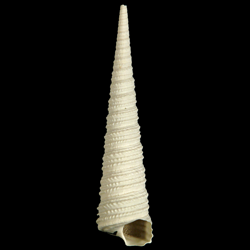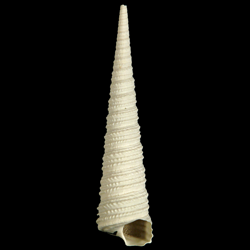
Turritellidae

- Phylum: Mollusca
- Class: Gastropoda
- Order: Caenogastropoda [Unassigned]
- Family: Turritellidae
Overview
Common name: Tower shells
Key morphological features: The Turritellidae have high-spired and narrow shells that lack an umbilicus. The shells are composed of aragonite and many have spiral ornamentation such as smooth or beaded cords. The aperture is relatively small and rounded, with a smooth, concave columella and a thin, curved outer shell lip. The shell lip is also prosocline near the suture. Some species (e.g., those of the genus Vermicularia) lack regular shell coiling as adults. Source: Davies, A.M. 1971. Tertiary Faunas Vol. 1, second edition. New York: American Elsevier Publishing Company, Inc. 571 pp.
Geological range: Cretaceous to Recent (Davies, 1971).
Geographic distribution: A distributional map for modern Turritellidae may be accessed from OBIS. A distributional map for ancient Turritellidae may be accessed from the Paleobiology Database.
Diversity: There are 137 recognized living species of Turritellidae and 18 genera (WoRMS database, unvetted). The Paleobiology Database recognizes 49 fossil genera and 913 fossil species of Turritellidae (unvetted).
Paleoecology: Species of Turritellidae tend to live infaunally or semi-infaunally in soft sediments in marine or estuarine waters, sometimes occurring in dense aggregations. Some species that lack regular shell coiling (e.g., those of the genus Vermicularia) can form reefs of inter-locking shells. They are predominantly ciliary suspension feeders, though may also be capable of grazing or deposit feeding. They are distributed worldwide in temperate to tropical waters and inhabit a wide range of depths ranging from the intertidal zone to approximately 1500m. Source: Allmon (1988).
Phylogenetic status: Monophyletic. The molecular phylogenetic analysis by Strong et al. (2011) supports the monophyly of Family Turritellidae.
